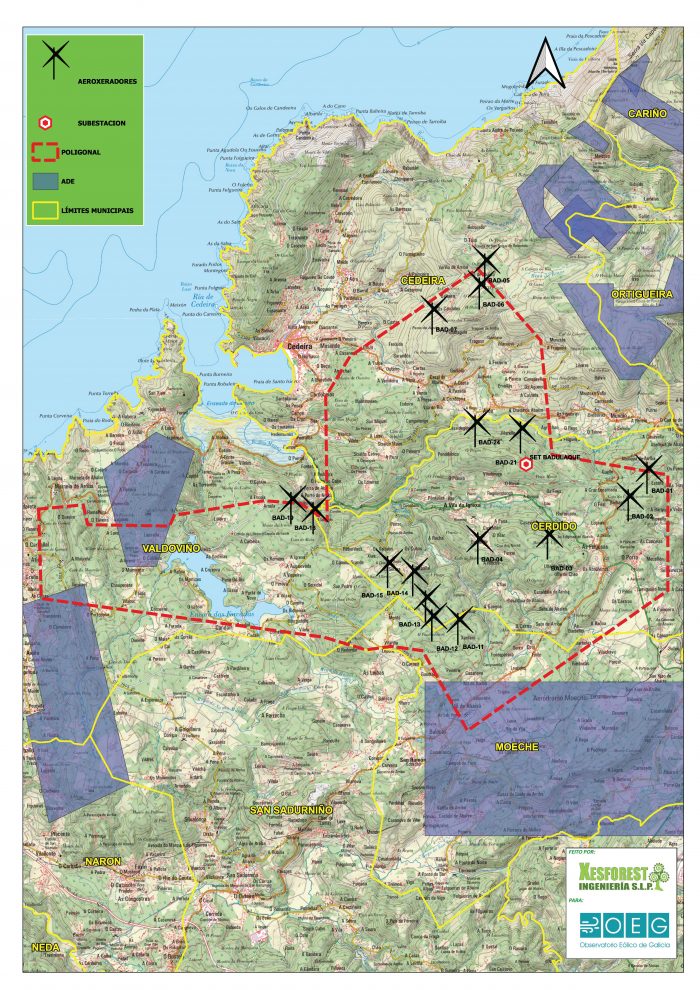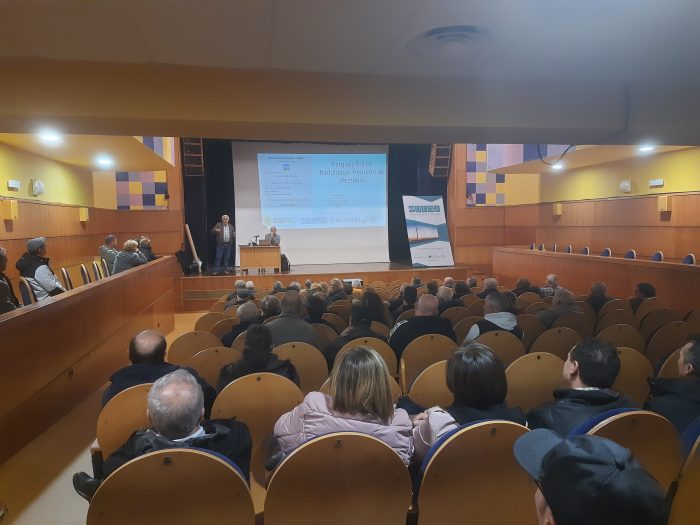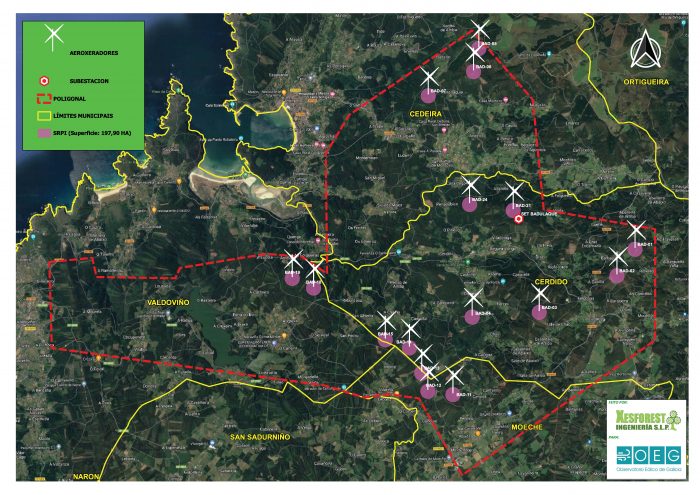
-
Facultade de Económicas
Universidade de Vigo
-
observatorio.eolico@uvigo.gal
-
Badulaque, a wind farm with over 8,000 hectares of competitor exclusion
- Home
- Wind Energy in Galicia
- Badulaque, a wind farm with over 8,000 hectares of competitor exclusion

- by OEGA
- 0 Comments
Based on the initiative of the Cedeira Wood Producers Association, the GWO visited the Cedeira City Council last week to carry out an advisory and information dissemination activity regarding the Badulaque wind farm.
The Facilities
The Badulaque wind farm is a vital component of what the Observatory, in collaboration with other social and environmental organizations, refers to as the Enel Green Power España, SL macro-wind farm situated in the eastern part of A Coruña and the adjacent municipalities of Lugo. This extensive project comprises five wind farms, boasting a cumulative capacity of 490 MW, featuring 128 turbines with individual capacities of up to 7 MW. Spanning over 100 kilometers, the interconnected wind farms share vital infrastructure, including substations, evacuation lines, and, notably, evacuation points. We use the term “macro-wind farm” because, despite the separate processing of each component, they collectively function as a unified production entity stretching from Xermade to As Pontes de García Rodríguez. Here, the significance of each installation is interconnected, and understanding one necessitates an appreciation of the others. This interdependence is marked by shared resources, highlighting the unity of the entire project. It’s essential to note that this characteristic is not a drawback; instead, it simply reflects the practical reality of a seamlessly integrated wind energy initiative.
The Badulaque wind farm, operated by a subsidiary of the renowned Italian public company Enel and formerly owned by the Spanish public company Endesa, is slated to receive an investment of approximately 142 million euros. This funding will facilitate the establishment of a 102.4 MW park, comprising 16 turbines with blade tip dimensions of 200 meters each. The anticipated outcome of this project is an annual production of nearly 4,700 hours, representing a remarkable level of productivity that nearly doubles the current average output of wind farms in the Galician region. One distinctive feature of this park is the strategic placement of all its turbines and facilities outside the designated Wind Development Areas. These areas are typically deemed viable according to the “old” Galician Wind Sector Plan. This deviation is facilitated by amendments to the plan, implemented through specific measures enacted by the Xunta de Galicia. These changes were prompted by the approval of Law 9/2021 on February 25, focusing on administrative simplification and fostering the economic reactivation of Galicia. The law explicitly stipulates, “Wind farms cannot be established outside the areas included in the Wind Sector Plan of Galicia, with the exception of substantial modifications to operating wind farms in terms that are regulated. Additionally, this exception encompasses projects with a clear territorial impact due to their economic and social significance. These projects must have a structuring function in the territory and be officially declared as such by the Council of the Xunta de Galicia, based on the proposal of the Ministry responsible for energy matters.”

Furthermore, Badulaque has already secured administrative authorization through a resolution from the Directorate General of Energy Policy and Mines of the Spanish government in April 2023. However, the company has subsequently sought a new authorization for a modified project, grounded in the Environmental Impact Statement (EIS). This revised plan involves a reduction in the number of turbines, an increase in their individual power, and an overall boost in the park’s power capacity.
Meeting with the Community
In a packed auditorium in Cedeira, Professor Simón focused his presentation on sharing with the community the effects of the park on the land, the estimated business volume associated with the park, and some data on the expected impact on local economies. The activity concluded with an enriching discussion among the attendees.

The GWO representative noted that the developer has not yet requested public utility status for the facilities, so land expropriation is not an option in the short term. Without a list of affected goods and rights, the total area for which the company is willing to pay an annual rent is unknown (its representatives in the area are already negotiating with residents). Our recommendation remains the same: joint negotiations are better than individual ones; hasty decisions are not good advisers (since the wind farm is there to stay on that land for a lifetime, the authorization has no expiration date); the standard contract developed by the GWO should be a good starting point for both parties; the support of municipalities (the mayor of Cedeira, Pablo Diego Moreda Gil, was present) is crucial for ensuring that benefits to the community, not just landowners, are adequate to compensate for loss of income, landscape disruption, machine noise, environmental damage, etc.

Professor Simón informed residents about changes in urban planning qualification, detailing areas where owners will lose rights as the designation shifts from forestry or common rustic to infrastructure protection rustic. Specifically, the affected zone, focused on the turbines, will encompass nearly 200 hectares. Additionally, Areas of Overlap or competitor exclusion zones will extend to almost 8,300 hectares. In an unfortunate twist, the company, in the vast majority of this affected area, will not compensate rightful owners despite the loss of basic rights over their properties. This situation raises concerns about social and economic injustice, a situation exacerbated by the regulatory framework endorsed by the Galician government.
Badulaque’s Wind Business
By considering the estimated production provided by the company, we have projected revenue based on the energy selling price. For instance, if the price aligns with the 2020 average, the revenue will reach 25 million euros. This figure significantly escalates to nearly 60 million with the 2021 average price. Furthermore, with the 2022 average price, the annual revenue is estimated to soar to 82 million euros. Even if the price aligns with that of September 2023, the annual revenue is projected to reach nearly 54 million euros. These figures represent a substantial economic impact, especially for rural and coastal municipalities like Cedeira, Cerdido, Moeche, or Valdoviño, portraying an astronomical economic scale for these communities.
The municipalities would receive a single payment for the Construction, Installations, and Services Tax of almost 5.7 million euros (assuming all apply the maximum allowed percentage of 4%), reaching almost 3.2 million for Cerdido, considering the distribution based on the number of turbines. Annual payments for the Special Property Tax would reach 200,000 euros (to be distributed among the 4 municipalities), and the Economic Activities Tax would go up to 97,000 euros annually for all of them. In addition, the Xunta would collect almost 95,000 euros for the wind tax.

The company’s offers for the occupied lands (aside from not accounting for all effects and losses, as previously mentioned) appear inconsequential when juxtaposed with the estimated revenue. For complete ownership, the company proposes a rate of 0.7 euros per square meter, while for easements, the offered rate is 0.35 euros. These figures starkly contrast with the 1.17 euros identified in some contracts for the first type of attachment, and they fall considerably short of easement payments outlined in other contracts, reaching 0.58 euros per square meter. A noteworthy perspective was shared by Apromace’s president, Julio Aneiros, who emphasized that “the company should compensate for these lands as a wind or energy site, not as forest land.” He pointed out that a eucalyptus acre traditionally yields 30 euros a year, whereas the company’s offer stands at 150 euros per acre. Julio contended that the value of the land is intricately linked to wind production, not wood production. In a further illustration, he questioned, “If we compare it to the eucalyptus acre, how many clearings should they consider? One clearing or two hundred?”
During the discussion, attendees expressed surprise that some companies remunerate landowners based on a percentage of revenue, a practice that, as Simón noted, “does not impede the wind business.”
Final Debate
In the final debate, new perspectives surfaced from the citizens. Those without land ownership but with significant projects near the wind farm voiced their discontent, deeming it entirely unjust that their rural way of life is on the brink of transformation due to the advent of large industrial installations that were neither requested nor promised to bring them direct benefits. Other residents raised concerns about isolated houses potentially being within a distance of less than 500 meters from the turbines, anticipating substantial harm as a consequence. An additional intervention questioned why everything was being assessed solely in monetary terms, emphasizing that rural life encompasses much more than financially considerations. In a concluding remark, a farmer highlighted the imminent land losses he would endure due to the Badulaque project, underscoring that the proposed compensation from the company wouldn’t even match what he receives from CAP subsidies.
Conclusion
The wind farm is set to become a permanent fixture in Cedeira, lasting for a lifetime.
The best strategy is for all landowners to unite and advocate for what they perceive as the best outcome for the town.
Municipal support plays a pivotal role in maximizing the positive economic impact retained within Cedeira while minimizing potential damages.
The GWO has developed a standardized contract that proves beneficial for all involved parties.